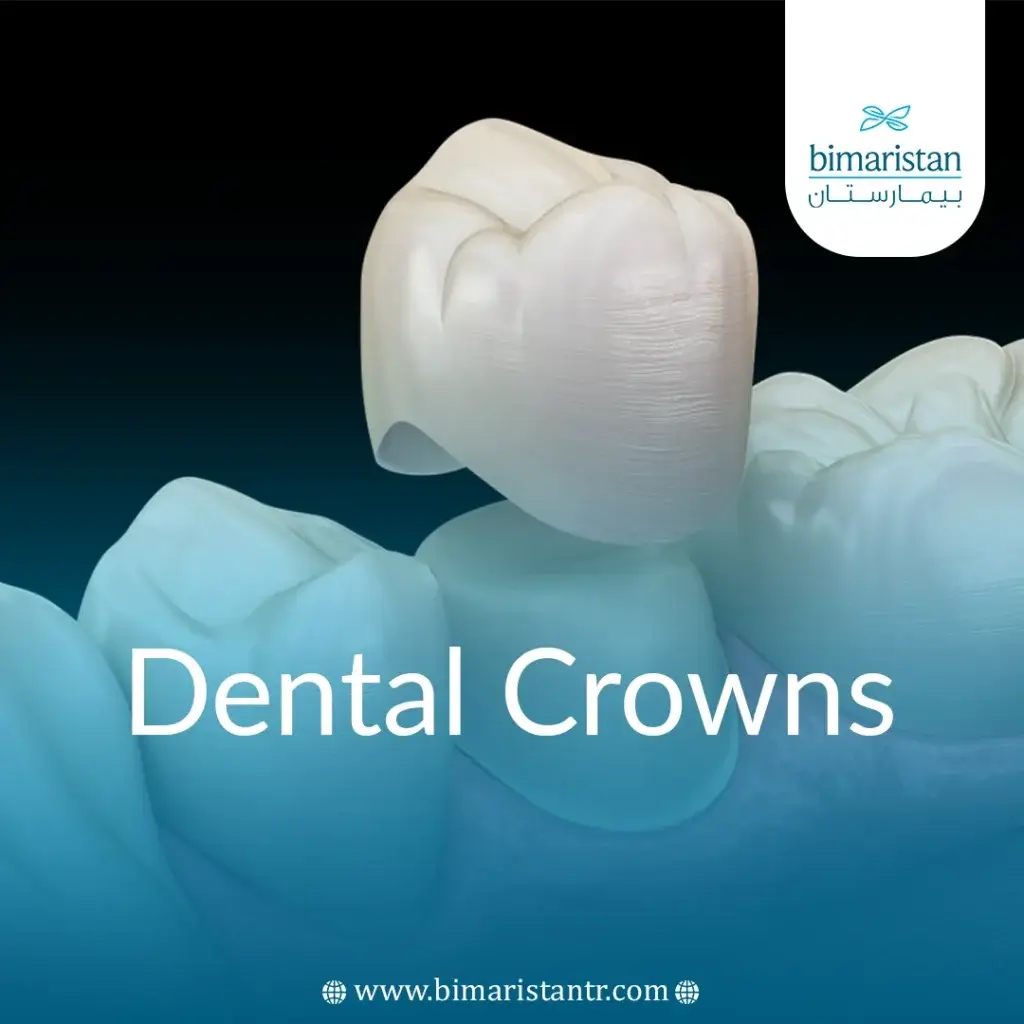In this article, you can learn about the types of dental crowns used in prosthodontics and the best types of dental crowns used in Turkey and Istanbul.
What is dental crowning?
Dental crowns can help restore broken, cracked, and decayed teeth.
A crown is a tooth-shaped cap that surrounds the entire visible portion of the tooth. There are several reasons why someone might wear a crown:
- To restore broken, damaged, or chipped teeth
- To increase the strength of weak teeth
- If the tooth is decayed and too much of the filling has been lost
- To improve the cosmetic appearance of teeth
- To restore a tooth that previously had a filling that was too large and might fall apart
- To strengthen and fill the tooth at the root canal (the space inside the tooth)
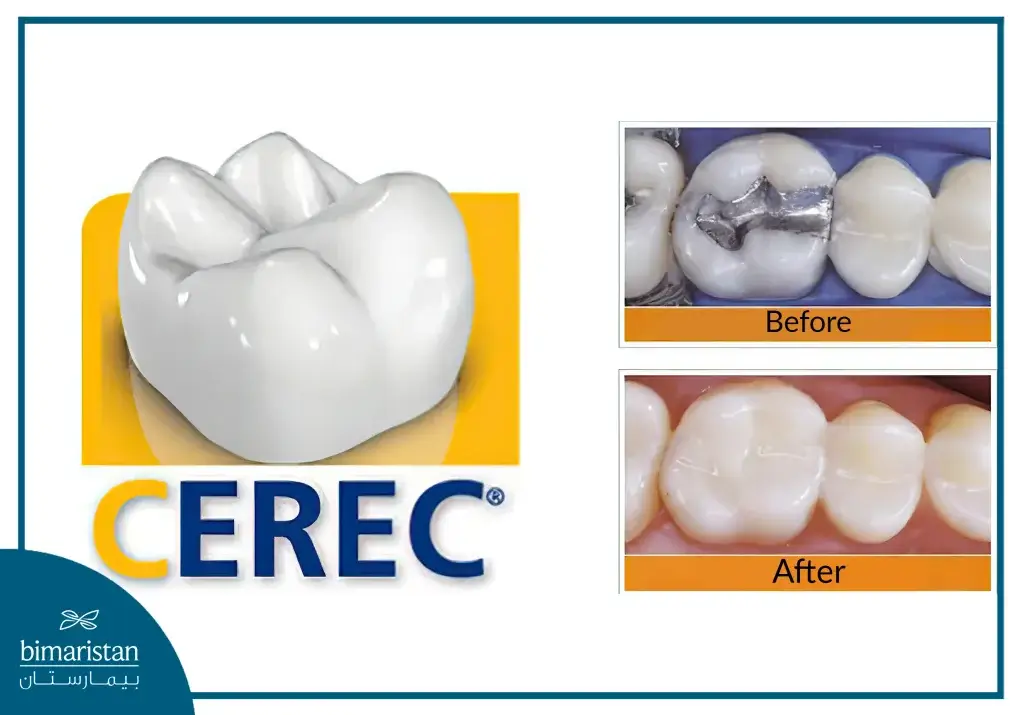
Crowns can be made from different materials. Some are metallic in color, while others are designed to look like natural teeth.
Before dental technology evolved to allow for dental crowns, the only way to deal with damaged or severely decayed teeth was to remove them. Thanks to dental crowns, dentists now have a way to preserve much of the tooth structure and avoid the discomfort of tooth extraction or live a lifetime with a removable prosthesis, such as a full denture or partial denture.
Unlike a dental filling, which only repairs part of the tooth, a crown restores the entire tooth. It enables the covered tooth to function like a natural tooth.
What is the difference between a dental crown and a dental cap?
You may have heard the terms “crown” and “cap” and wondered what the difference is. Well, crown and cap are both names for the same thing.
“Tooth cap” is a less technical term for “dental crown,” but both refer to a complete tooth cap placed over a drilled tooth. Some people might say that the “crown” is metallic in color while the “cap” is tooth-colored, but for dentists, this is not a significant difference.
We’ll use both terms interchangeably in this article, but by now, you know they refer to the same thing.
Another term that may refer to a dental crown is “inlay.” An inlay is a similar restoration that can be created more conservatively to maintain healthy tooth structure.
Types of Dental Crowns
The most common materials for making dental crowns are:
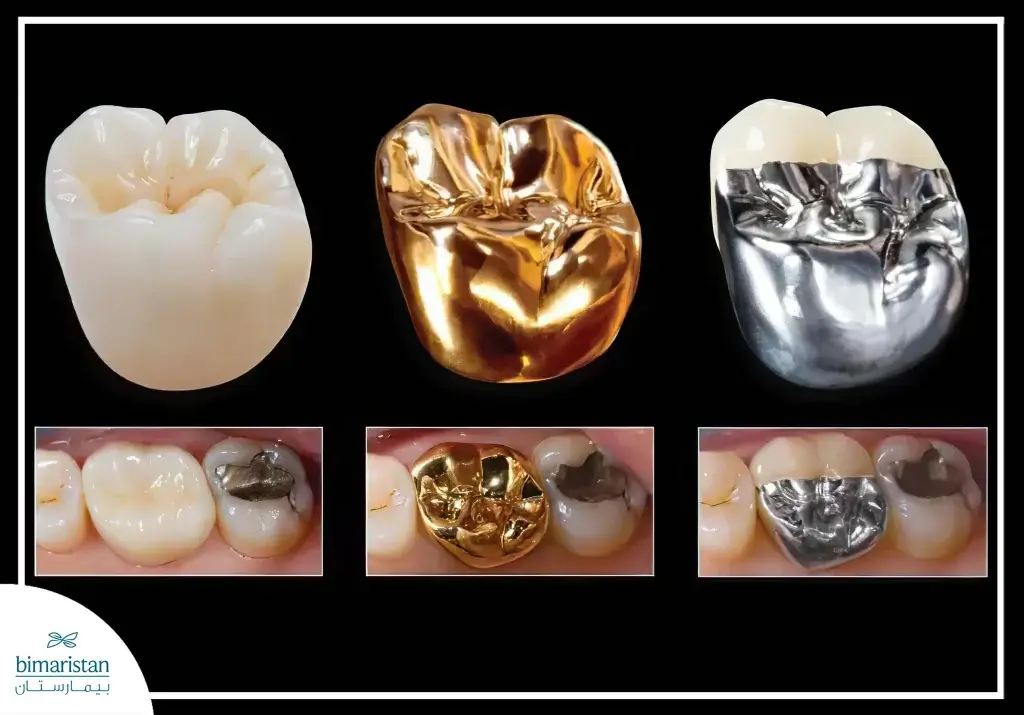
- Ceramics: Can include porcelain or zirconia, colored to match the surrounding teeth.
- Metalalloys: These include gold, platinum, palladium, and non-precious metals, which are either “white” (silver-colored) or “yellow” (gold-colored). Some people may get gold crowns because they like the aesthetics of gold teeth.
- Porcelain Fused to Metal (PFM): A combination of the above, with fused ceramic in an internal metal crown.
- Resin: Cheaper than other types and doesn’t last as long – can be used for temporary crowns while you wait for a permanent crown.
The best material for dental crowns in Turkey
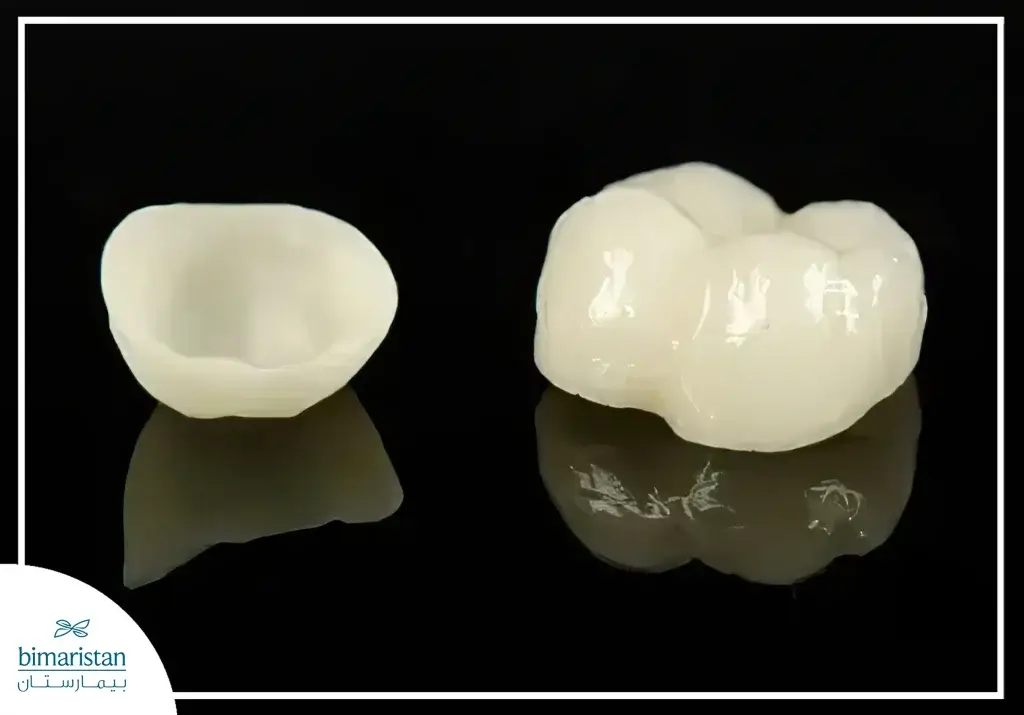
Each dental crown material has advantages and disadvantages, so the right crown material for you will depend on the teeth being covered, the aesthetic you want, and how long it needs to last.
Porcelain crowns are made in a lab and built up layer by layer. This gives them the same semi-transparent appearance as natural teeth and makes them a popular choice for front teeth that will show when speaking or laughing. They can also be made chairside using a new technique for milling crowns. These are great because they can be placed in just one visit without the need for a temporary crown.
The downside of any ceramic material is that while it is very strong, it is more fragile than metal and is prone to cracking or damage over time. Still, when manufactured properly, it can be expected to last for more than 15 years.
Gold dental crowns and dental crowns made of other metal alloys are more durable. They have the added benefit of being biocompatible with the teeth, which means that the covered teeth should not cause any damage or wear to the biting (uncovered) teeth. A gold crown can last a lifetime if the patient does their homework to maintain their hygiene and health.
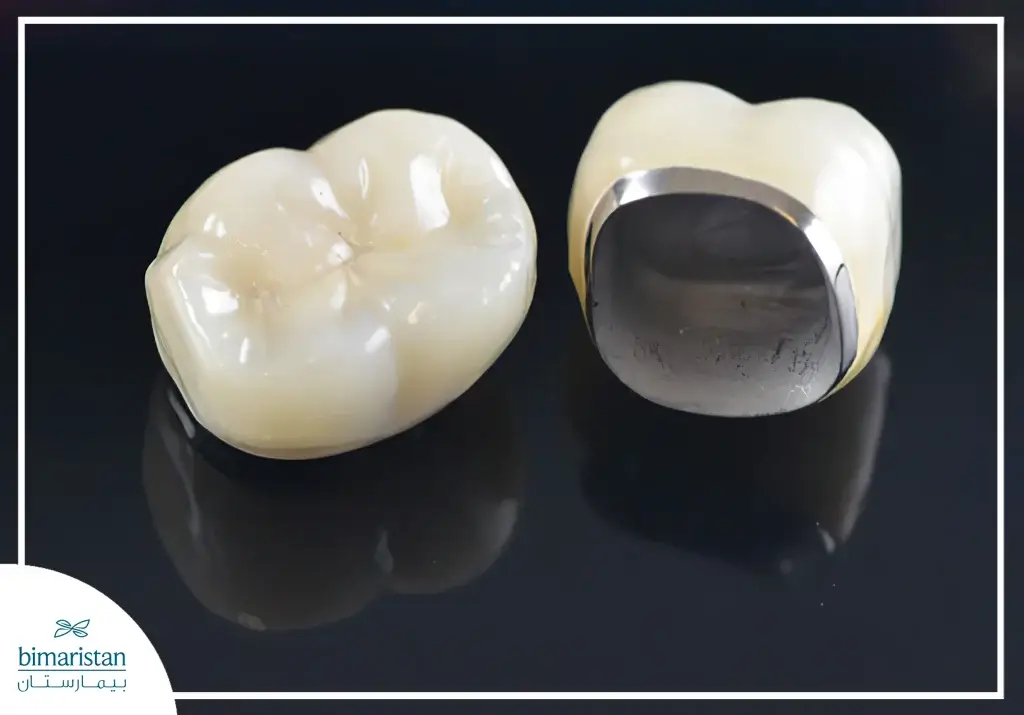
The obvious disadvantage of any metal crown is the color. Many people simply don’t want gold or silver-colored teeth in their mouths, even if they are hidden in the back.
For others, having a gold-toothed crown is very appealing, and they may even have it engraved or set with precious stones!
Metal-fused porcelain crowns offer some of the strength of metal with the aesthetics of porcelain crowns. However, because they are layered, they usually don’t look exactly like natural teeth. The ceramic coating can still be chipped or damaged, but the metal underneath will remain intact. If the gum recedes over time, a dark gray metal line can be seen and can be considered quite unattractive.
How much does a crown cost without health insurance in Turkey?
Silver dental crowns cost 300 TL to 700 TL, while all-porcelain crowns sometimes cost up to 1,500 TL each. While crowns are expensive, they are an essential part of many dental procedures and should not be discarded just because of their price.
As with any dental treatment, dental cap prices vary greatly from place to place and from one dental clinic to another. It’s worth comparing prices between dentists near you, especially if you need to crown more than one tooth.
There is also more to consider than just the cost of a dental cap; as discussed above, each type of crown has pros and cons. In addition to asking your dentist about dental crown costs, inquire about the different options that may be right for you. It’s a good idea to ask your dentist what they would choose in their mouth if they found themselves in a similar situation.
As you can see from the table below, full metal crowns are generally the least expensive, and full ceramic is the most expensive. Front dental crowns can be more expensive as more time is required to give them a natural look.
| Taj Cirik by one day | Metal crown | Ceramic crown (porcelain) | Porcelain Fused to Metal (PFM) Crown | Type of crown |
| 700 – 2,000 | 300 – 700 | 800 – 2,000 | 600 – 1,800 | Cost |
| It can be cut just like porcelain | Excellent; long-lasting | The least likely durable material to break or chip | Although the metal inside is strong, the porcelain outside can crack | Strength/Durability |
| The fast-paced production process makes achieving a natural look difficult | Easily noticeable in gold or silver color | Created to look like natural teeth | Colored teeth, but not always as transparent as natural teeth | Aesthetic |
| The other teeth you bite can gradually wear down | Won’t damage other teeth | The other teeth you bite can gradually wear down | The other teeth you bite may gradually wear down | Other notes |
If you need more than one crown, your dentist may offer you a lower price per crown. However, the material and time costs for each crown remain pretty much the same, no matter how many you have.
Minimizing the cost of tooth crowns in Turkey
While metal crowns may be cheaper, while private dental insurance may cover some or all of the costs you incur at different stages of the process, this treatment is often only covered after a waiting period – usually between three months and one year after your insurance has kicked in.
If you choose to get dental caps for cosmetic reasons, check if your insurance policy covers this.
Read more about dental plans in Turkey, including what is and isn’t covered by some providers. Keep in mind that you may have to pay for root canal treatment (an empty space between teeth) in addition to your crown.
For purely cosmetic improvements, dentures (veneers) may also be an option. Talk to your dentist to find out which option is best for you.
Dental crown surgery in Turkey
First visit: Preparation
The crowning procedure involves removing about 1 to 2 millimeters of tooth structure to ensure a proper fit and long-lasting function.
But before that, your dentist may take an X-ray to make sure your teeth are healthy enough to invest in and check for any underlying complications. If all is well, your dentist will numb your teeth and surrounding gums with an anesthetic, which is a type of dental anesthesia.
Root canal treatment (the empty space) may be necessary before a crown if you have pain, severe cracking, or decay in the nerve. Your dentist may also surgically remove some gum tissue to create a better base for the cap.
Your dentist will also remove all traces of decay and any material from previous fillings. If a large section of the tooth has been removed, he or she may build it back up using a filling material. Once this is done, the tooth preparation should include a slight filling to be thinner at the top so that the dental cap can slide over it easily.
Next, the dentist takes an impression or digital scan of what’s left of the tooth so he or she can create a crown that fits perfectly. The crown can take 2-3 weeks to make in a specialized lab, so the dentist places a temporary cap (made of resin or acrylic) to stop any sensitivity in the tooth and keep it functional and looking nice in the meantime.
The color of the temporary dental cap should match your natural teeth, but the material and finish are not as high quality as the eventual permanent cap. At this point, your dentist will also choose the shade for your crown if you’re going to make it out of a material that matches your teeth.
This first visit usually lasts between 45 minutes and one hour.
Second Visit: Installation
Once the permanent crown arrives, you will visit the dentist again to have it fitted. The temporary cap will be removed, and the dentist may numb the tooth again to avoid any sensitivity during this time.
Dentists use precision drills to make improvements when fitting crowns.
After checking that the new crown fits perfectly, your dentist will place a dental adhesive or resin adhesive inside the crown and press it down over your tooth. Any excess that has leaked out of the crown will be scraped off, and the process is complete.
If you have any concerns about the color or shape of your permanent crown (especially for crowns on front teeth), make sure to talk to your dentist before installing it. Also, make sure your dentist allows you to take a look at it before the final installation. Consider going out to look at it in natural light, which can be more accurate. It’s hard to make any changes once your new dental cap is in place, and you’ll have to live with it for a long time!
The duration of this second visit depends on the number of adjustments needed before the crown is fixed, but on average, it takes 30 minutes – 1 hour.
Your covered teeth may look a little strange at first because they won’t look exactly like your original teeth. As long as they don’t bite your tongue, you should get used to them within a couple of weeks.
CEREC crown installation in one day
There is an option on the market that lets you avoid multiple visits and weeks or months with a temporary crown.
CEREC crown technology allows dentists to create crowns on-site within an hour or so from digital scans of your mouth. This is undoubtedly a more convenient option for patients, and many are happy to forgo the unpleasant dental impression process.
CEREC crowns are relatively new to the market, which means that not much data is available on their long-term performance. However, dentists generally agree that while they are a strong and aesthetically pleasing option for back teeth, they cannot match the natural look of handmade porcelain crowns for front teeth.
These dental crowns cost almost as much as regular crowns because even though no lab work is required and the process is faster, the dentist has to pay more for the machine that makes them.
Recovery and care of dental crowns
How long do dental crowns last?
Although crowns are a long-term solution for restoring damaged teeth, they don’t last forever. Some materials are more durable than others; gold, for example, won’t chip or corrode like porcelain does.
Your dentist may tell you to expect your crown to last 5 to 15 years, but many last much longer than that. A 2013 study evaluated 2,340 metal-fused porcelain-type gold crowns and found that 97% lasted more than 10 years, while 85% were still going strong after 25 years.
Photo
Even golden crowns can eventually wear out
The crown will eventually need to be replaced if:
- Crash or break (ceramics)
- Corrode (metal) or cause excessive wear on other teeth (ceramic)
- The tooth has decay on the inside
- Deterioration of its cosmetic appearance (in the case of anterior dental crowns)
Gold dental crowns are generally the strongest, but they can wear down in some places if the patient suffers from teeth grinding (bruxism). This condition can also be an issue for patients with porcelain crowns as this material is more likely to damage the other teeth it bites into. If you grind your teeth at night, it may be smart to invest in a custom-made night guard to keep your teeth and natural crowns protected. It’s much cheaper than crowning several teeth due to wear and tear!
Ask your dentist: What are the benefits of a crown?
A dental crown is used to restore and strengthen damaged teeth or to replace missing teeth. A crown, also referred to as a cap, is used to completely cover a damaged tooth. A crown not only strengthens the tooth, but it can also significantly improve the appearance, shape, and alignment of the tooth.
Temporary crowns are a good option to help resolve a patient’s current issue before a permanent crown is made and cemented in place. However, temporary crowns are more sensitive to breakage, so extra care should be taken when brushing, flossing, and eating.
You can learn about the clear 3D braces
Caring for a temporary cover
While the temporary dental cap is in place, you should avoid any chewy or sticky foods (such as gum or soft candy) that might pull it off. It’s also best to avoid hard foods, such as raw carrots and apples. Try to bite and chew primarily on the side of your mouth away from the crown, or use the crowned tooth only to bite into very soft foods.
Caring for your permanent dental cap
Your dentist may advise you to avoid hard, chewy foods for the first day after your crown is fitted. This gives the ceramic enough time to adjust properly. Once you regain normal feeling in your mouth, carefully test the bite of your crown in all directions.
If you feel anything strange, report it to your dentist immediately. He or she can optimize the shape and make sure your crown doesn’t interfere with your other teeth. A stain that feels too high won’t go away on its own and can eventually cause tooth and jaw pain.
In the long term, teeth with crowns should be cared for in the same way as regular teeth by brushing twice daily and flossing daily. If you’re worried about flossing hitting the edge of your crown, consider using a water flosser instead. You should be able to eat whatever you want, but don’t use your teeth or crowns as a tool – don’t open a plastic bag. Grab a pair of scissors!
If your gums start to recede, it can cause tooth sensitivity in parts of the tooth that are not covered by the cap. So, it’s important to minimize the risk of gum disease by having your teeth cleaned regularly by a dental hygienist.
In the case of metal-fused porcelain caps, if the filling recedes downward where the ceramic coating was applied, the metal will begin to show, resulting in a visible line at the gum line.
If your crown cracks or comes out completely, contact your dentist immediately so they can assess the damage. The chips can be temporarily filled with resin or dental repair kits, but the only permanent solution is a full crown replacement. It is possible to reattach a crown that has come out, provided there is no damage to it.
Crown wear issues
When you get a dental crown, you may experience the following issues:
Allergies
Newly crowned teeth can cause sensitivity after the crowning procedure. However, if you still experience crown pain, especially when biting down, you should contact your dentist so they can fix it.
Loose crown
The ceramic that holds your crown to the tooth can wear away, causing your crown to become loose. This exposes the teeth and gums underneath to harmful bacteria, so it’s important to see your dentist if you think your crown is loose.
Crown tooth hurts years later
If you feel pain years after you get the crown, this could be a sign of an infection or nerve trauma. It is important to contact your dentist.
Throbbing pain in the teeth after a crown
This could be a sign of a loose tooth crown, further damage to the tooth, or an infection. You should contact your dentist.
Fall of the crown
If your crown falls off, you should call your dentist for an appointment. Keep the crown secure, and do not chew on the exposed tooth in the meantime.
Broken crown
Small chips in crowns can be repaired, while larger pieces may require replacement. Either way, contact your dentist if your crown is cracked.
Dental crowns or caps protect damaged teeth. Teeth can be damaged from decay, injuries, or wear and tear over the years. Crowns resemble teeth and can be placed over teeth. They are comfortable and stabilizing for permanent wear and are usually made of metal, porcelain, or resin.
Porcelain crowns have the most natural look, but they can wear out faster than metal crowns. Many people choose to have porcelain or ceramic teeth in the front and stronger metal crowns for the back molars. Occasionally, a crown can become loose or fall off. If this is the case with your tooth, it’s important to see your dentist to get it fixed as soon as possible.
You can learn about dental implants using a 3D printer.
Sources:
